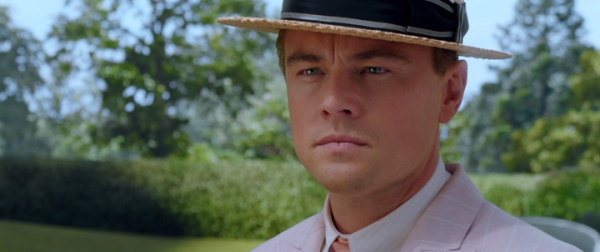The ad campaign for Baz Luhrmann’s The Great Gatsby is pretty snazzy, the movie itself is a mess. The poster’s anachronistic Art Deco silver-gold letters on a black grid evoke the chrome of shiny old Dusenbergs plus the velvet casing of jewelry boxes. It’s about luxury and that’s what the media response (foregrounding Luhrmann’s $125 million budget and hyping Jay-Z’s irritating hip-hop music score) respects above movie content.
When we talk about this Great Gatsby, the event and advertising hype are more meaningful than the film. It signifies a transfer in cinema’s cultural impact from narrative enjoyment to the transient processes of commercialism. Interest in this film derives from political and cultural forces exemplified by advertising, not F. Scott Fitzgerald’s 1925 novel which romanticized working class 1920s bootlegger Jay Gatsby (played by an aged, agitated Leonardo DiCaprio) whose social-climbing obsession centers on Daisy (Carey “Cry-baby” Mulligan), the flame of his youth now married to rich, bigoted lout Tom Buchanan (Joel Edgerton, cartooned).
Fitzgerald’s tale here loses its trenchant all-American subject. Luhrmann trades the story of Gatsby’s personal striving for another pointless exercise in excessive computer-generated gimmickry and pop-culture hodge-podge. Media shills, ignorant of film style, submit to this visual torture as if it were original or effective. Luhrmann’s signature camera move changes the zoom into a whoosh–a simulated evocation of cinema’s most glorious kinetic gesture. What an Italian film critic once described as “the bliss of camera movement” becomes an over-amped, unnatural sensation.
Scale and spatial logic disappear, so does any emotional dimension. Luhrmann bloats Fitzgerald’s slim, breezily-worded tale to a draggy, repetitious and pretentious epic. Ideas about class (hidden points about ethnicity), details about desire, frustrated idealism and American history get both dragged-out and run-over. Luhrmann’s screen images whiz around Long Island and Manhattan just as they did Paris in his 2002 Moulin Rouge, destroying any realistic sense of place or experience. Luhrmann’s visual exaggeration is like Gatsby’s corrupt aspirations: he asks “You think it’s too much?” after sending a roomful of flowers to Daisy yet doesn’t heed when told “I think its what you want.”
Instead of representing an authentic modern vision, Luhrmann’s lack of narrative skill destroys comprehension so completely that he inadvertently exposes the novel’s flaws. Luhrmann’s own opportunism reveals Fitzgerald’s. The important subtext of Gatsby’s (ne Jay Gatz) attempts at Wasp integration is lost. His mentor Meyer Wolfsheim becomes an Indian Bollywood figure; Daisy and Tom’s friend Jordan Baker’s haunting line “We’re all white here” is omitted; and narrator Nick Carraway is turned into a sycophantic dolt (miscast Tobey Maguire gives the most googly-eyed performance in recent screen history).
Carraway’s voice-over narration sounds like he just learned to read which may be the key to Luhrmann’s Attention Deficit Disorder directorial style; it replaces visual significance and precision. Making a Great Gatsby that looks like both a comic book movie and Peter Jackson’s King Kong reduces our culture to little more than a TV commercial marketing Hollywood product.
This Gatsby is only about the profit-making potential of what movie exhibitors used to call “film exploitation” and it confirms our news media’s surrender to that goal.
Follow Armond White on Twitter at 3xchair

